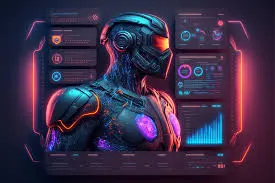Have you ever wondered how the world of graphic design is progressing with the rise of AI? Today, professional artists are experiencing significant changes in the way they create and design. Visualize thanks to the integration between AI and graphic design.
In this article, we will discuss how AI is changing the face of the graphic design industry bringing new options and tools for artists.
How is AI revolutionizing graphic design in the arts?
Below are some examples of how AI is revolutionizing graphic design in the arts:
- Automated Design: AI automates layout tasks, freeing designers for creativity.
- Personalized Solutions: AI creates designs tailored to user preferences.
- Style Transfer: AI mimics artistic styles, expanding creative options.
- Photo Editing: AI enhances editing with features like background removal.
- Predictive Analytics: AI predicts trends, guiding designers for relevance.
- Accessibility: AI adds features like image recognition for inclusivity.
The Emergence of AI in Graphic Design
AI, or artificial intelligence, is real now and used in many industries, like graphic design.
New tools can learn and change, making creativity and efficiency easier. One big topic is AI-generated art, which are pictures made by computer programs, not just people.
These are systems for analyzing trends such as styles, techniques and color palettes before generating intricate one-of-a-kind designs.
Adding Artificial Intelligence to graphics has changed how designs are made and made art more creative.
Enhancing Creativity with AI Tools
AI helps artists get better at being creative. It gives them ideas in various ways, like suggesting colors.
AI can quickly make whole scenes or designs. This helps artists focus on making their work look good, instead of doing boring tasks.
When artists use AI for these tasks, they have more freedom to be creative. They can try new things and come up with fresh ideas. This makes the creative process more exciting and full of possibilities.
Artificial intelligence
Artificial intelligence helps a lot in graphic design by making things faster and easier.
With AI, tasks that used to take hours can now be done in minutes. This means projects get finished quicker, and there’s more time to do other work. It’s good for both artists and clients.
This kind of efficiency is especially useful in sectors where time is of the essence, like advertising or marketing.
AI helps designers create great designs quickly, so they can finish their work on time and impress clients.
Researchers discovered two important ideas about what customers like when things are customized or personalized.
Automation
- Repetitive Tasks: Simple tasks like making pictures smaller, arranging words, or working on many files at once can be done automatically. This saves designers a lot of time and work.
- Consistency: Automation makes sure that design things stay the same. This means keeping the colors, fonts, and styles of a brand consistent in a project or on different platforms.
- Speed: When designers use automation for regular tasks, they can work faster. This helps them finish work on time and handle more tasks without making them less good.
- Error Reduction: Automation makes it less likely for people to make mistakes. This helps in making things and designs with fewer errors and more accuracy.
- Template Creation: AI tools can make design templates for different things like social media or presentations. These templates help designers start their work and change things as they want.
- Workflow Optimization: Automation makes design workflows better by working with other software tools, making processes smoother, and cutting down on manual work.
- Version Control: Automated systems help keep track of changes in design projects. This makes sure that everyone on the team can always access the newest files.
- Data-Driven Design: Automation makes designs using data. It creates visuals based on live data or what users input.
Automation helps graphic designers concentrate on creative problem-solving and strategic thinking by letting AI tools handle repetitive and time-consuming tasks. This makes designers more productive and helps them achieve better results faster.
Generative Design
- Generative design programs make lots of different designs using given rules. These designs can give us new and clever ideas we might not think of on our own.
Adapting to Emerging Trends
AI constantly changes to keep up with design trends. This helps artists stay competitive and updated in a changing industry.
AI tools study trends and predict future ones. They give helpful ideas that can help with artistic projects. By being able to see and adjust to changes in the industry, designers can make sure their work stays modern and meaningful.
Collaborative Efforts Between Humans and AI
Artists and AI work together. AI gives tools and ideas. Artists add creativity and a human touch. Together, they make designs that are interesting and useful.
Mixing intuition with AI’s abilities makes a good mix of creativity and efficiency.
Artists use AI to try new things. AI gets better with human help. They make designs that matter and have an impact.
Predictive Analytics
Predictive analytics looks at old info and current trends to guess what design trends might come next. This helps designers make designs that people will like.
It can guess how well different design parts, like colors or layouts, will do based on what’s happened before. This helps designers pick the best design parts for their goals.
It can find patterns in how content does and suggest changes to make it do better. For instance, it might say to switch up headlines or where to put pictures to get more people interested.

